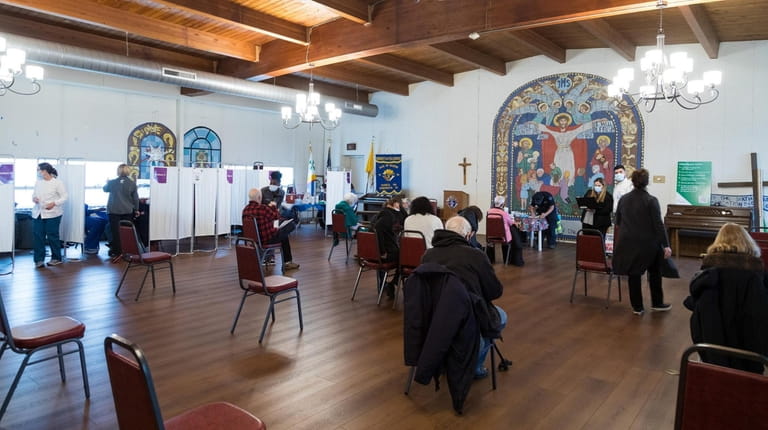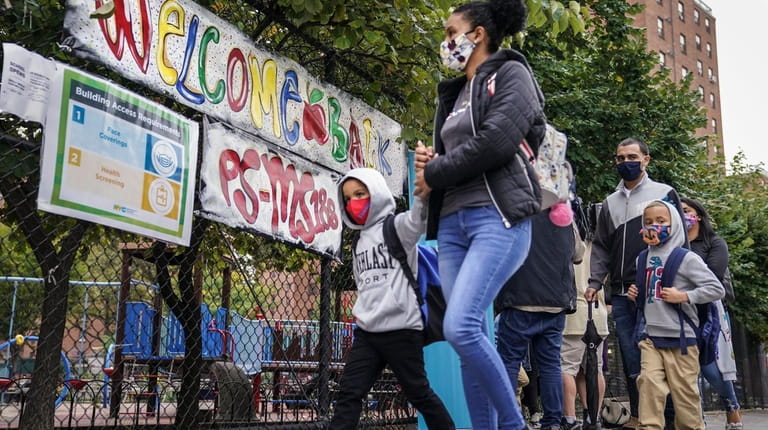State: Adult care facilities completing first round of COVID-19 shots within weeks

This story was reported by Matthew Chayes, Lisa L. Colangelo, John Hildebrand, Bart Jones, David Reich-Hale and Joie Tyrrell. It was written by Jones.
Residents in adult-care facilities in New York are expected to receive at least the first shots of COVID-19 vaccine within the next three weeks, officials said Tuesday, as they move to protect one of the most vulnerable populations amid the pandemic.
Jonah Bruno, a spokesman for the state Department of Health, said the shots should be done by Feb. 11.
People in nursing homes and assisted living residences are a priority for the first rounds of vaccinations, according to state and federal officials.
The federal program to vaccinate people at adult-care locations was rolled out on Jan. 11, with pharmacy chains administering the shots. The same federal government program, which contracted with chains such as CVS and Walgreens, also has been vaccinating nursing home residents and staff.
While every resident is offered the vaccine, they’re not mandated to take it and could turn it down for medical or personal reasons.
The nursing home rollout began in December, and Gov. Andrew M. Cuomo said last week that the first round of vaccinations at those facilities had been completed. Many Long Island nursing homes have said in recent weeks that they’ve received second doses.
Those programs were advancing while the state in general was struggling with insufficient supplies of vaccine.
Though some 7 million people are eligible for the shots, New York has been receiving about 250,000 doses a week from the federal government. President Joe Biden on Tuesday pledged to increase deliveries for states immediately.
As of 11 a.m. on Tuesday, the state's health care distribution sites had received 1,304,050 first doses and administered 93%, or 1,210,339, of first dose vaccinations, the state reported.
Of 564,600 second doses received, 166,640, or about 30%, have been administered. There is typically a three- to four-week gap between doses, depending on the vaccine used.
Delivery of the seventh-week allocation from the federal government will not begin to arrive until the middle of this week, Cuomo said.
"We know the vaccine is the weapon that ends the war. That's why New York has built a vast infrastructure of providers and pop-up sites to get shots in arms quickly and fairly on a massive scale. The only problem — we don't have nearly enough supply," Cuomo said.

People who received COVID-19 vaccinations wait 15 minutes after getting the vaccine Tuesday in the observation area at St. Hugh of Lincoln Roman Catholic Church in Huntington Station. Credit: Barry Sloan
Cuomo said the state could "easily" administer 100,000 doses a day.
At the Gurwin Jewish-Fay J. Lindner Residences, an assisted-living facility in Commack, nearly all 156 residents are expected to be vaccinated when Walgreens returns to their location on Feb. 8. Walgreens first visited the facility on Jan. 18.
"We are very pleased, and we communicate in advance with each visit, when we tell them how many people we expect to be vaccinating," said Stuart B. Almer, the CEO of Gurwin, adding that he hopes a plan will roll out that "would allow for any residents or staff who have yet to be vaccinated to be accommodated."
Suffolk County said Tuesday it expects to receive 2,700 doses from the New York State Department of Health this week and will focus on vaccinating essential workers, first responders and other people in Phase 1B.
Nassau County officials also said they expect to receive vaccine doses this week, but could not say how many. They pointed to state guidance which says they must use it to vaccinate people in the 1B group of eligible residents.
GETTING COVID-19 VACCINES IN NY
- To complete a prescreening and find sites to schedule COVID-19 shots, people in the eligible lists can visit https://am-i-eligible.covid19vaccine.health.ny.gov/
- State residents may call the New York State Vaccination Hotline: 1-833-NYS-4VAX (1-833-697-4829)
- Northwell Health is booking its COVID-19 vaccine appointments online at northwell.edu/covidvaccine
- Call or visit your local pharmacist to check for participation in the state's vaccination effort.
- The state's phase distribution guidelines can be found at: https://covid19vaccine.health.ny.gov/phased-distribution-vaccine
Who qualifies for COVID-19 shots?
The State of New York has expended its eligibility list for vaccines against COVID-19 several times, expanding the groups of people included in the phases. This is a summary of the eligible groups. The following are the qualifying categories, as revised on March 29.
Group in Phase 1A
The state said about 2.1 million state residents belong in this group, including:
- Health care workers at hospitals who interact with patients.
- Residents and staff at nursing homes and assisted living facilities.
- Dentists, psychologists and others deemed health care workers with direct contact with patients.
- Employees of Federally Qualified Health Centers.
- EMT volunteers and staff.
- Coroners, medical examiners, some funeral workers.
- Staff and residents of state facilities for people with developmental disabilities, mental health care and addiction services.
- Employees at urgent care centers.
- Individuals administering COVID-19 vaccines, including local health department staff.
- Staff at ambulatory centers.
- Home care and hospice workers.
- Residents and staff at other congregate care facilities.
Group in Phase 1B
The state estimated about 3.2 million residents belong in this group, including:
- People 75 years of age and older.
- Teachers and education workers, including in-person college instructors, substitute teachers, student teachers, school administrators, paraprofessional staff, support staff, contractors in schools and bus drivers.
- First responders, including police; firefighters; state police; sheriff’s offices; county, town and village police departments, and other law enforcement offices.
- Public safety workers, including dispatchers and technicians.
- Public transit workers, including airport, railroad, subway, bus, ferry and Port Authority employees.
- Corrections officers.
- Other sworn and civilian personnel, such as court and peace officers.
- Grocery store workers dealing with the public.
- Individuals living in homeless shelters.
Following federal recommendations:
- Since Feb. 15, people at risk of moderate to severe illness due to health conditions, immunocompromised status or comorbidities, including ailments such as high blood pressure, diabetes, cancer and chronic kidney disease. The full list of qualifying conditions is listed with the announcement on the state's website.
Added at the discretion of local governments:
- Taxi drivers.
- Restaurant workers.
- Residents of facilities for developmentally disabled people.
- Hotel workers who interact with the public.
Other expansions of eligibility:
- State residents age 60 and older (Since March 10, 2021).
- “Public-facing” government and public employees (Since March 17, 2021).
- Workers for not-for-profit organizations who provide “public-facing” services (Since March 17, 2021).
- Building service workers who are “public-facing” employees (Since March 17, 2021).
- State residents age 50 and older (Since March 23, 2021).
Since March 30, 2021:
- State residents age 30 and older.
Since April 6, 2021:
- State residents age 16 and older.
SOURCE: New York State, Northwell Health.
Faced with the scarce supply, New York City Mayor Bill de Blasio said Tuesday he wants to start using second doses as first shots.
"I’ve got 100,000 second doses that right now are sitting on a shelf — they can’t be used for weeks. And what I would ask of the president is, order governments all over the country, just take those second doses and start using ’em right now, because even a first dose gives folks about 50% protection," de Blasio said.
Dr. Anthony Fauci, director of the U.S. National Institute of Allergy and Infectious Diseases, has said he is concerned that delaying the second shot would be less effective, since clinical trials showed the Pfizer and Moderna vaccines prevented COVID-19 infections when two doses were given, 21 and 28 days apart.

New York City Mayor Bill de Blasio said Tuesday the city aims to reopen its middle and high schools for in-person classes, but gave no timeline. In the file photo, students arrived with parents and guardians to return to classes at a lower Manhattan school in September. Credit: AP/John Minchillo
Virus positivity inched down
The state continued to register a general post-holiday season decrease in positivity levels and new confirmed cases.
The statewide positivity in results from Monday was 6.79%, with the seven-day average registering at 6.9% on Long Island, still the highest level in the state, and 5.81% statewide.
The number of new confirmed cases was 942 in Nassau County, 1,135 in Suffolk County, and 5,081 in New York City.
A total of 162 people died in the state of coronavirus-related causes on Monday, including 10 in Nassau and 15 in Suffolk.
The number of people hospitalized with the virus across the state increased by 101, to a total of 8,831, according to state data released Tuesday.
Meanwhile, Northwell Health on Tuesday said the number of hospitalized COVID-19 patients continues to drop in its health system, including at its Long Island facilities.
The largest health system in the state said it was caring for 1,310 COVID-19 patients, down from 1,384 at the same period a week ago. At the height of the pandemic in April, Northwell reported more than 3,400 COVID-19 patients.
New Hyde Park-based Northwell said it had 617 COVID-19 patients in Long Island hospitals, down from 684 a week ago.
On Long Island, students and instructional staff at the Caroline G. Atkinson School in Freeport were placed on remote instruction this week due to new COVID-19 cases, with a planned reopening on Feb. 1.
Students at Drexel Avenue School in Westbury switched to remote learning after a staff member tested positive for COVID-19. Officials said they would provide another update to specify a return to in-person instruction.
With wire services
Sign up for COVID-19 text alerts at newsday.com/text.
